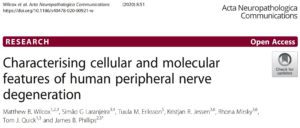New paper characterising human nerve degeneration
This study reveals new information about the cellular and molecular features of human nerves following injury. Published in Acta Neuropathologica Communications (Open Access), this collaborative work analysed nerve tissue from patients undergoing repair surgery. Since the patients had surgery at various different times after the original injury, it was possible to build up an understanding of how nerve tissues change over days, months and years following damage.

Using immunohistochemistry and Real-Time quantitative Polymerase Chain Reaction (RT-qPCR), the expression of SOX10, c-Jun, p75NTR and EGR2 was assessed in denervated samples and compared to healthy nerve. The patterns of changes seen in the human samples were similar to those reported previously in rodent models, with Schwann cells adopting a repair phenotype in acutely injured nerves, which then fades during chronic denervation. Understanding the timing of these changes in human nerve tissue following injury should help to inform the development of better therapeutic interventions.
More information about the study is provided in this UCL News Item and the paper can be accessed via this link. The project involved Matthew Wilcox, Simao Laranjeira, Tuula Eriksson, Kristjan Jessen, Rhona Mirsky, Tom Quick and James Phillips and was a multidisciplinary collaboration within the UCL Centre for Nerve Engineering.
Read more: News